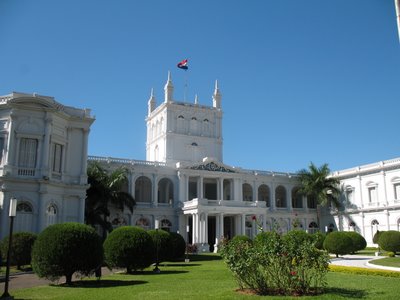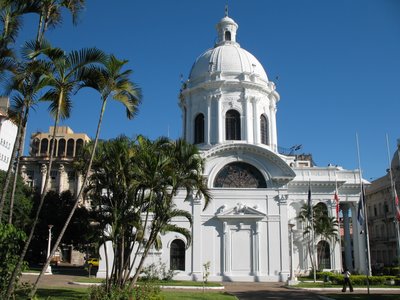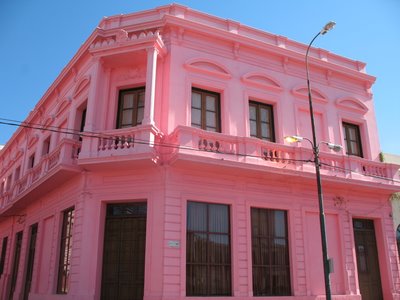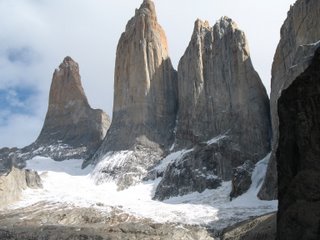Paraguay
Landlocked Paraguay has been described as "An island surrounded by a sea of land" by its most famous author. Its a little off the beaten track for most travellers but after reading John Gimlette´s excellent historical travelogue on Paraguay At the Tomb of the Inflatable Pig, I was quite keen to see what the country was really like. The book tells the story of Paraguay´s colourful history, the result of a succession of despotic rulers since independence in 1811. For example, the country´s first president, General Francia, ordered anyone gazing at the front of his palace, shot on sight. Then there was the power-crazy Francisco Solano Lopez, who took on the might of Brazil, Argentina and Uruguay simultaneously in 1865, in a mad bid to expand his territory. The resulting War of the Triple Alliance cost Paraguay a quarter of its territory and half its population. In 1932, Paraguay went to war with Bolivia, over the potentially oil rich Chaco, a conflict that was encouraged on both sides by oil multinationals hoping to reap the rewards. The Chaco War gave Paraguay the lions share of the harsh environment but since then little oil has been found. Between 1954 and 1989, Paraguayan´s endured the brutal military dictatorship of General Stroessner, where political opponents were intimidated or murdered and corruption became the way of life. Stroessner was overthrown after 35 years but his Colorado party have continued to dominate politics and regained control in the 2003 elections. The assassination of Colorado vice-president Luis Argaña in 1999 shows things have improved little. President Raul Cubas and General Lino Oviedo, were linked to the murder and both sought asylum in Brazil. Contraband and corruption still dominate the economy and outside the cities, the majority of people are subsistence farmers. For the full story on the country´s history, I highly recommend Gimlette´s book.

I entered the country from Brazil via Ciudad del Este, one of Latin America´s biggest shopping centres, largely due to the high volume of contraband that is smuggled here. Streams of Brazilians were crossing the bridge into Paraguay in search of a bargain. The chaotic city streets didn´t really tempt me to stay so I got a bus straight to the capital Asuncion. Once out on the open road, it was clear that I´d crossed into a much poorer country and that was still quite evident in Asuncion too, large parts of the city are run down, but it does have its charms. Its riverside setting on the Rio Parana and balconied colonial buildings add to the exotic remoteness. The people were friendly, almost surprised to encounter a tourist, but I did really struggle to understand the Paraguayan Spanish. After finding a cheap hotel where I was the only guest and a good nights sleep, I went out to explore the sights, the Goverment palace, Casa Viola, the Cathedral, the Casa de la Independecia and the Plaza de los Heroes, where the remains of Paraguay´s crazed leaders are guarded.


Having decided to get a bus to Bolivia later that evening, I intended to spend my last few hours of that afternoon relaxing in a nearby park. However en route to the park, I got a little lost and wandered into a shanty town on the rivers edge. It soon dawned on me that it wasn´t a very safe area and I quickly began to backtrack my way out. Before I could make my way back to safety, I was grabbed by two young men, who tried to wrestle my day pack from me. They quickly had me in a lock and as I struggled to break free I could see plenty of other locals watching, some looking like they might join in and take a share of the spoils. The youths had pulled the pack off my back but I somehow managed to wrestle it back off them almost losing my balance in the process. My head was spinning but I staggered free and amazingly they appeared to give up. I didn´t pause to reflect and quickly hot-footed it out of there feeling very lucky to have escaped with my possessions, sans cap, which had been lost in the struggle. The incident left me feeling quite shaken and I was glad to board the bus that night, in the company of a few other gringos and the long journey across the Chaco began.
The road soon turned from tarmac to dirt and the bus bumped along through the night, I managed to get a few hours sleep before we were woken at 4am, in the middle of nowhere at a passport control point. The new day dawned to the backdrop of the thick scrub forest of the Chaco. Surprisingly, this dry inhospitable environment is the second most diverse ecosystem on the continent, although most of the wildlife is elusive and nocturnal. Lots of colourful birds could be seen flying around the treetops for the first few hours but the scenery soon became quite monotonous with just the odd estancia to break up the forest and the temperature on the bus began to soar. We reached the Paraguayan customs hut around midday in baking 35C heat and a short while later, went through the slow process of clearing Bolivian customs. We collected our entry stamps at another stop, two hours up the road at a larger village, amid more Bolivian beauraucracy. It was late afternoon by the time we reached civilisation at the small town of Villamontes and the road reverted to tarmac. Another 7 hours later we reached the city of Santa Cruz and it was a relief to find somewhere where a nice comfy bed awaited me - it had been an arduous 27 hour journey.

I entered the country from Brazil via Ciudad del Este, one of Latin America´s biggest shopping centres, largely due to the high volume of contraband that is smuggled here. Streams of Brazilians were crossing the bridge into Paraguay in search of a bargain. The chaotic city streets didn´t really tempt me to stay so I got a bus straight to the capital Asuncion. Once out on the open road, it was clear that I´d crossed into a much poorer country and that was still quite evident in Asuncion too, large parts of the city are run down, but it does have its charms. Its riverside setting on the Rio Parana and balconied colonial buildings add to the exotic remoteness. The people were friendly, almost surprised to encounter a tourist, but I did really struggle to understand the Paraguayan Spanish. After finding a cheap hotel where I was the only guest and a good nights sleep, I went out to explore the sights, the Goverment palace, Casa Viola, the Cathedral, the Casa de la Independecia and the Plaza de los Heroes, where the remains of Paraguay´s crazed leaders are guarded.


Having decided to get a bus to Bolivia later that evening, I intended to spend my last few hours of that afternoon relaxing in a nearby park. However en route to the park, I got a little lost and wandered into a shanty town on the rivers edge. It soon dawned on me that it wasn´t a very safe area and I quickly began to backtrack my way out. Before I could make my way back to safety, I was grabbed by two young men, who tried to wrestle my day pack from me. They quickly had me in a lock and as I struggled to break free I could see plenty of other locals watching, some looking like they might join in and take a share of the spoils. The youths had pulled the pack off my back but I somehow managed to wrestle it back off them almost losing my balance in the process. My head was spinning but I staggered free and amazingly they appeared to give up. I didn´t pause to reflect and quickly hot-footed it out of there feeling very lucky to have escaped with my possessions, sans cap, which had been lost in the struggle. The incident left me feeling quite shaken and I was glad to board the bus that night, in the company of a few other gringos and the long journey across the Chaco began.
The road soon turned from tarmac to dirt and the bus bumped along through the night, I managed to get a few hours sleep before we were woken at 4am, in the middle of nowhere at a passport control point. The new day dawned to the backdrop of the thick scrub forest of the Chaco. Surprisingly, this dry inhospitable environment is the second most diverse ecosystem on the continent, although most of the wildlife is elusive and nocturnal. Lots of colourful birds could be seen flying around the treetops for the first few hours but the scenery soon became quite monotonous with just the odd estancia to break up the forest and the temperature on the bus began to soar. We reached the Paraguayan customs hut around midday in baking 35C heat and a short while later, went through the slow process of clearing Bolivian customs. We collected our entry stamps at another stop, two hours up the road at a larger village, amid more Bolivian beauraucracy. It was late afternoon by the time we reached civilisation at the small town of Villamontes and the road reverted to tarmac. Another 7 hours later we reached the city of Santa Cruz and it was a relief to find somewhere where a nice comfy bed awaited me - it had been an arduous 27 hour journey.


0 Comments:
Post a Comment
<< Home